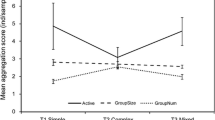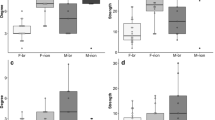Abstract
Previous research has shown that competition, familiarity, diet, and relatedness can all influence aggregation patterns in garter snakes. We controlled for these factors and examined social aggregation patterns in juvenile Eastern garter snakes (Thamnophis sirtalis sirtalis). We assayed snakes individually for consistent individual differences in boldness and sociability. We then placed snakes in groups of 10 in an enclosure with four shelters and observed their social interactions over a period of 8 days. We demonstrate that the snakes actively seek social interaction, prefer to remain with larger aggregates, and associate nonrandomly with specific individuals or groups. We show that their social interaction patterns are influenced by individual boldness, sociability, and age. The snakes’ social networks were perturbed twice a day by “shuffling” their locations. Despite these disturbances, the snakes eventually re-formed their preferred social environment. Aggregation and exploration patterns also varied across time, with most activity occurring later in the day. These results highlight the complexity of snake sociality and may have important implications for conservation efforts.
Significance statement
Snakes are often considered nonsocial animals, but this is inaccurate. We used social network analyses to compare juvenile Eastern garter snakes’ group behaviors to their individual personalities. Our research demonstrates that these snakes actively seek out social interaction and prefer to join and remain with larger groups and that their social interaction patterns are influenced by consistent individual differences in boldness and sociability. Our work contributes to a sparse but growing body of literature on sociability in reptiles. This work is important for changing perceptions among the scientific community and the public as a whole. As a consequence, it may aid efforts in developing appropriate conservation techniques that consider sociability patterns in relocated reptiles.



Similar content being viewed by others
References
Alexander G (2018) Reproductive biology and maternal care of neonates in southern African python (Python natalensis). J Zool 305:141–148. https://doi.org/10.1111/jzo.12554
Allee E (1934) Recent studies in mass physiology. Biol Rev 9:1–48. https://doi.org/10.1111/j.1469-185X.1934.tb00872.x
Bevan PA, Gosetto I, Jenkins ER, Barnes I, Ioannou CC (2018) Regulation between personality traits: individual social tendencies modulate whether boldness and leadership are correlated. Proc R Soc B 285:20180829. https://doi.org/10.1098/rspb.2018.0829
Bonnet X, Shine R, Lourdais O (2002) Taxonomic chauvinism. Trends Ecol Evol 17:1–3. https://doi.org/10.1016/S0169-5347(01)02381-3
Burghardt G (1977) Of iguanas and dinosaurs: social behavior and communication in neonate reptiles. Am Zool 17:177–190
Burghardt G (1983) Aggregation and species discrimination in newborn snakes. Z Tierpsychol 61:89–101. https://doi.org/10.1111/j.1439-0310.1983.tb01330.x
Burghardt G (1990) Chemically mediated predation in vertebrates: diversity, ontogeny, and information. In: Macdonald DW, Muller-Schwarze D, Natynczuk SE (eds) Chemical signals in vertebrates 5. Oxford University Press, Oxford, pp 475–499
Carpenter C (1953) A study of hibernacula and hibernating associations of snakes and amphibians in Michigan. Ecology 34:74–80. https://doi.org/10.2307/1930310
Chiszar D, Carter T, Knight L, Simonsen L, Taylor S (1976) Investigatory behavior in the plains garter snake (Thamnophis radix) and several additional species. Anim Learn Behav 4:273–278. https://doi.org/10.3758/BF03214049
Clark R, Brown W, Stechert R, Greene H (2012) Cryptic sociality in rattlesnakes (Crotalus horridus) detected by kinship analysis. Biol Lett 8:523–525. https://doi.org/10.1098/rsbl.2011.1217
Cote J, Clobert J (2007) Social personalities influence natal dispersal in a lizard. Proc R Soc Lond B 274:383–390. https://doi.org/10.1098/rspb.2006.3734
Cote J, Fogarty S, Weinersmith K, Brodin T, Sih A (2010) Personality traits and dispersal tendency in the invasive mosquitofish (Gambusia affinis). Proc R Soc Lond B 277:1571–1579. https://doi.org/10.1098/rspb.2009.2128
Dinets V (2017) Coordinated hunting by Cuban boas. Anim Behav Cogn 4:24–29. https://doi.org/10.12966/abc.02.02.2017
Dodd C, Seigel R (1991) Relocation, repatriation, and translocation of amphibians and reptiles: are they conservation strategies that work? Herpetologica 47:336–350. https://doi.org/10.1016/0006-3207(92)91063-X
Doody JS, Burghardt G, Dinets V (2013) Breaking the social-non-social dichotomy: a role for reptiles in vertebrate social behavior research? Ethology 119:95–103
Dundee H, Miller M (1968) Aggregative behavior in habitat conditioning by the prairie ringneck snake, Diadophis punctatus arnyi. Tulane Stud 15:41–58
Edsinger E, Dölen G (2018) A conserved role for serotonergic neurotransmission in mediating social behavior in octopus. Curr Biol 28:3136–3142. https://doi.org/10.1016/j.cub.2018.07.061
Farine D (2013) Animal social network inference and permutations for ecologists in R using asnipe. Methods Ecol Evol 4:1187–1194. https://doi.org/10.1111/2041-210X.12121
Graves B, Duvall D (1987) An experimental study of aggregation and thermoregulation in prairie rattlesnakes (Crotalus viridis viridis). Herpetologica 43:259–264
Graves B, Duvall D (1995) Aggregation of squamate reptiles associated with gestation, oviposition, and parturition. Herpetol Monogr 9:102–119. https://doi.org/10.2307/1466999
Graves B, Halpern M (1988) Neonate plains garter snakes (Thamnophis radix) are attracted to conspecific skin extracts. J Comp Psychol 102:251–253. https://doi.org/10.1037/0735-7036.102.3.251
Greene HW, May PG, Hardy DL, Sciturro JM, Farrell TM (2002) Parental behavior by vipers. In: Schuett GW, Höggren M, Douglas ME, Greene HW (eds) Biology of the vipers. Eagle Mountain Publishing LC, Eagle Mountain, pp 179–206
Gregory PT (2004) Analysis of patterns of aggregation under cover objects in an assemblage of six species of snakes. Herpetologica 60:178–186. https://doi.org/10.1655/02-101
Guayasamin OL, Couzin ID, Miller NY (2017) Behavioural plasticity across social contexts is regulated by the directionality of inter-individual differences. Behav Process 141:196–204. https://doi.org/10.1016/j.beproc.2016.10.004
Hatchwell B (2010) Cryptic kin selection: kin structure in vertebrate populations and opportunities for kin directed cooperation. Ethology 116:203–216. https://doi.org/10.1111/j.1439-0310.2009.01732.x
Heller S, Halpern M (1981) Laboratory observations on conspecific and congeneric scent trailing in garter snakes (Thamnophis). Behav Neural Biol 33:372–377. https://doi.org/10.1016/S0163-1047(81)92136-1
Heller S, Halpern M (1982) Laboratory observations of aggregative behavior of garter snakes, Thamnophis sirtalis. J Comp Physiol Psychol 96:967–983
Hoss S, Deutschman D, Booth W, Clark R (2015) Post-birth separation affects the affiliative behaviour of kin in a pitviper with maternal attendance. Biol J Linn Soc 116:637–648. https://doi.org/10.1111/bij.12604
Jolles JW, Boogert NJ, Sridhar VH, Couzin ID, Manica A (2017) Consistent individual differences drive collective behavior and group functioning of schooling fish. Curr Biol 27:2862–2868. https://doi.org/10.1016/j.cub.2017.08.004
Krause J, Ruxton G (2002) Living in groups. Oxford University Press, New York
Larsen KW, Gregory PT, Antoniak R (1993) Reproductive ecology of the common garter snake Thamnophis sirtalis at the northern limit of its range. Am Midl Nat 129:336–345. https://doi.org/10.2307/2426514
Loughran C, Beck D, Weaver R (2015) Use of communal shedding sites by the northern Pacific rattlesnake (Crotalus oreganus oreganus) in Central Washington state. Northwest Nat 96:156–160
Luiselli L (1996) Individual success in mating balls of the grass snake, Natrix natrix: size is important. J Zool 239:731–740. https://doi.org/10.1111/j.1469-7998.1996.tb05474.x
Lyman-Henley L, Burghardt G (1994) Opposites attract: effects of social and dietary experience on snake aggregation behaviour. Anim Behav 47:980–982. https://doi.org/10.1006/anbe.1994.1131
Mason RT, Crews D (1985) Female mimicry in garter snakes. Nature 316:59–60. https://doi.org/10.1038/316059a0
Mayer M, Shine R, Brown GP (2016) Bigger babies are bolder: effects of body size on personality of hatchling snakes. Behaviour 153:313–323. https://doi.org/10.1163/1568539X-00003343
Nash DJ, Griffiths RA (2018) Ranging behaviour in adders (Vipera berus) translocated from a development site. Herpetol J 28:155–159
Nelson K, Gregory P (2000) Activity patterns of garter snakes, Thamnophis sirtalis, in relation to weather conditions at a fish hatchery on Vancouver Island, British Columbia. J Herpetol 34:32–40
Nobel G, Clausen H (1936) The aggregation behavior of Storeria dekayi and other snakes, with especial reference to the sense organs involved. Ecol Monogr 6:269–316. https://doi.org/10.2307/1943244
O’Donnell R, Shine R, Mason R (2004) Seasonal anorexia in the male red-sided garter snake, Thamnophis sirtalis parietalis. Behav Ecol Sociobiol 56:413–419. https://doi.org/10.1007/s00265-004-0801-x
Pawar S (2003) Taxonomic chauvinism and the methodologically challenged. BioScience 53:861–864. https://doi.org/10.1641/0006-3568(2003)053[0861:TCATMC]2.0.CO;2
R Core Team (2017) R: a language and environment for statistical computing. R Foundation for Statistical Computing, Vienna http://www.R-project.org
Reichenbach N (1983) An aggregation of female garter snakes under corrugated metal sheets. J Herpetol 17:412–413. https://doi.org/10.2307/1563599
Rossman D, Ford N, Seigel R (1996) The garter snakes: evolution and ecology (Animal natural history series, vol. 2). University of Oklahoma Press, Norman
Schuett GW, Clark RW, Repp RA, Amarello M, Smith CF, Greene HW (2017) Social behavior of rattlesnakes: a shifting paradigm. In: Schuett GW, Feldner MJ, Smith CF, Reiserer RS (eds) Rattlesnakes of Arizona, vol 2. Eco Publishers, Rodeo, pp 61–244
Shine R, LeMaster M, Moore I, Olsson M, Mason R (2001) Bumpus in the snake den: effects of sex, size, and body condition on mortality of red-sided garter snakes. Evolution 55:598–604. https://doi.org/10.1111/j.0014-3820.2001.tb00792.x
Shine R, Langkilde T, Mason RT (2003) Confusion within ‘mating balls’ of garter snakes: does misdirected courtship impose selection on male tactics? Anim Behav 66:1011–1017. https://doi.org/10.1006/anbe.2003.2301
Shine R, Shine T, Shine JM, Shine BG (2005) Synchrony in capture dates suggests cryptic social organization in sea snakes (Emydocephalus annulatus, Hydrophiidae). Aust Ecol 30:805–811. https://doi.org/10.1111/j.1442-9993.2005.01524.x
Shine R, Langkilde R, Mason RT (2012) Facultative pheromonal mimicry in snakes: “she-males” attract courtship only when it is useful. Behav Ecol Sociobiol 66:691–695. https://doi.org/10.1007/s00265-012-1317-4
Sih A, Cote J, Evans M, Fogarty S, Pruitt J (2012) Ecological implications of behavioral syndromes. Ecol Lett 15:278–289. https://doi.org/10.1111/j.1461-0248.2011.01731.x
Sprent P, Smeeton N (2001) Applied nonparametric statistical methods, 3rd edn. Chapman & Hall/CRC, Boca Raton
Stoffel M, Nakagawa S, Schielzeth H (2017) rptR: repeatability estimation and variance decomposition by generalized linear mixed-effects models. Methods Ecol Evol 11:1639–1644. https://doi.org/10.1111/2041-210X.12797
Tchernichovski O, Benjamini Y, Golani I (1998) The dynamics of long-term exploration in the rat. Part I. A phase-plane analysis of the relationship between location and velocity. Biol Cybern 78:423–432
Towns DR, Miller KA, Nelson NJ, Chapple DG (2016) Can translocations to islands reduce extinction risk for reptiles? Case studies from New Zealand. Biol Conserv 204:120–127. https://doi.org/10.1016/j.biocon.2016.04.024
Tukey JW (1977) Exploratory data analysis. Addison-Wesley, Reading
van Oers K, Drent PJ, de Goede P, van Noordwijk AJ (2004) Realized heritability and repeatability of risk-taking behaviour in relation to avian personalities. Proc R Soc Lond B 271:65–73
Wilkinson A, Kuenstner K, Mueller J, Huber L (2010) Social learning in a non-social reptile (Geochelone carbonaria). Biol Lett 6:614–616. https://doi.org/10.1098/rsbl.2010.0092
Wilson DS, Coleman K, Clark AB, Biederman L (1993) Shy-bold continuum in pumpkinseed sunfish (Lepomis gibbosus): an ecological study of a psychological trait. J Comp Psychol 107:250–260
Wisenden BD, Sailer CD, Radenic SJ, Sutrisno R (2011) Maternal inheritance and exploratory-boldness behavioural syndrome in zebrafish. Behaviour 148:1443–1456
Yeager C, Burghardt G (1991) Effect of food competition on aggregation: evidence for social recognition in the plains garter snake (Thamnophis radix). J Comp Psychol 105:380–386. https://doi.org/10.1037/0735-7036.105.4.380
Acknowledgments
The authors wish to thank Dr. Ken Maly for developing and performing the lipid extraction methodology used in the paper, Kelley Putzu for the assistance with animal care, and members of the Collective Cognition Lab for the assistance with running the experiment and coding the data. We also thank two anonymous reviewers for their helpful comments on an earlier version of the manuscript.
Funding
This research was funded by the National Science and Engineering Research Council of Canada (NSERC) grant RGPIN-2016-06138 (to NM).
Author information
Authors and Affiliations
Contributions
All authors contributed to the study conception, design, material preparation, and statistical analyses. The first draft of the manuscript was written by Morgan Skinner. All authors contributed to manuscript editing and further re-writes. All authors read and approved the final manuscript.
Corresponding author
Ethics declarations
Conflict of interest
The authors declare that they have no conflict of interest.
Ethical approval
All experimental procedures conformed with the Canada Council on Animal Care guidelines and were approved by the Wilfrid Laurier University Animal Care Committee (AUP R17004). The adult snakes (mothers of the experimental subjects) were collected from the Waterloo, Ontario, area under a Scientific Collector’s Permit from the Ontario Ministry of Natural Resources.
Data availability statement
The datasets generated and analyzed during the current study are available in the Open Science Framework repository, https://osf.io/jx9ve/.
Additional information
Communicated by T. Madsen
Publisher’s note
Springer Nature remains neutral with regard to jurisdictional claims in published maps and institutional affiliations.
Electronic supplementary material
ESM 1
(DOCX 1.01 MB)
Rights and permissions
About this article
Cite this article
Skinner, M., Miller, N. Aggregation and social interaction in garter snakes (Thamnophis sirtalis sirtalis). Behav Ecol Sociobiol 74, 51 (2020). https://doi.org/10.1007/s00265-020-2827-0
Received:
Revised:
Accepted:
Published:
DOI: https://doi.org/10.1007/s00265-020-2827-0




